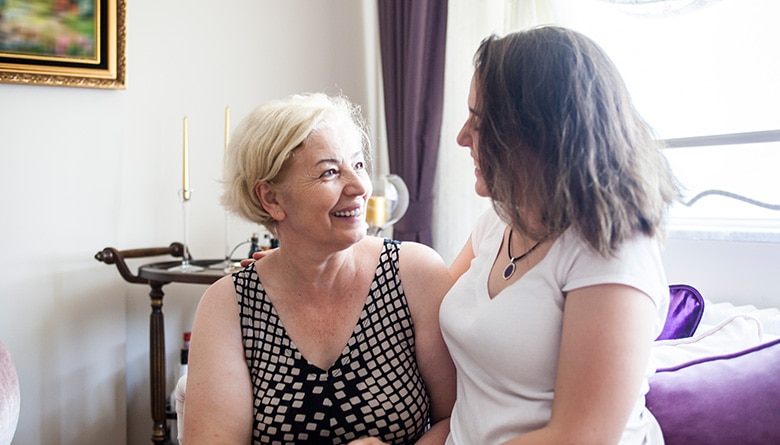Elements of design can have a significant impact on how a person living with dementia experiences the environment around them.
Good design can enable or support a person’s navigation or use of a space, especially if the space is unfamiliar. Who hasn’t found themselves confused about which exit to take from a shopping centre or which row our car is parked in? Imagine how much more difficult it would be if you had impaired short term memory, a loss of the ability to sequence actions, or loss of colour and depth in your visual field. These are common impacts of dementia.
A well designed enabling environment can support a person living with dementia to continue to lead a full and active life by reducing the disabling impact of cognitive impairment.
On the flip side, a poorly designed environment can be confusing, disorientating and inaccessible for a person living with dementia.
There is very limited guidance on dementia specific design in the Australian Accessibility Standards or Universal Design guidelines. This aspect of design is often neglected and overlooked by architects and urban designers when designing and creating houses, gardens, public buildings and spaces. With over 70 per cent of people with dementia continuing to live in their own home, and who want to continue engaging in the community, it is time to consider how public buildings and local community spaces could better support those with dementia.
Colour contrast, lighting, choice of wall and flooring materials, and signage can all play a significant part in how a person living with dementia experiences the environment they are in. By making even the smallest of changes you could make a big difference.
If a person is no longer able to walk you can adapt the environment to assist them to continue accessing and using it. In the same way you can use design to overcome some of the disabilities of dementia. Some of the more common difficulties a person living with dementia may have include wayfinding and orientation, spatial perception (that is identifying the 3D spaces or objects around them), sensitivity to visual and audio stimulation, and using unfamiliar objects.
The use of colour to contrast or highlight key areas or objects in the home can make it easier for a person living with dementia to navigate and identify things. Colour contrasting door handles, toilet seats and even bathroom taps can help a person to more easily identify these items. Colour contrast can also be used effectively with crockery – for example a blue plate on a white tablecloth is easier to see than a white plate on a white tablecloth.
Use of colour and strong patterns on surfaces such as flooring, fabric or wallpaper can make the environment more challenging for a person living with dementia.
People with dementia may lose their depth of vision. Highly contrasting patterns on the floor (such as a checker-board pattern or a dark floor mat on a light floor) may be perceived to be changes in floor level or ‘holes’ in the ground. Similarly, changes in flooring type, especially where the colour is visibly different, can create a perceived step or hole in the floor. The same principle applies to highly decorative or patterned rugs, which can also present a trip hazard.
Exposure to natural light can assist in general wellbeing and in differentiating between day and night. By opening curtains and blinds fully to maximise daylight and enhance vision, you will support wayfinding and safe walking in the home. Where natural light is not an option, consider replacing light globes with higher wattage ones or adding additional task lighting to further support good lighting levels within the home.
Use signs on doors such as the bathroom and toilet to support movement and engagement, especially if in a new home. You could also label cupboard doors and drawers with their contents using pictures and words that are easily recognisable.
Enabling dementia design need not be limited to just the home. The principles of good dementia design can also be applied to public buildings, hospitals, outdoor and garden spaces.
If you are interested in finding out how to make your home and garden a dementia enabling environment, our Dementia Enabling Environment website has information you can use within your home, as well as for private and public gardens, public buildings, hospitals and residential care facilities.
The website responds to the growing recognition of the positive difference enabling environments can have for people living with dementia. It is an Australian first in that it translates enabling environments research into practice and focuses on architecture, interior design and gardens.
Use the website and its interactive illustrations as a visual guide to creating a dementia enabling environment within each room of your home. Alternatively, contact us for a wide range of practical, inexpensive and useful ideas, examples and recommendations as well as resources to make necessary changes, and to evaluate the outcomes.
By making some simple and positive changes within your home you can maximise enablement and wellbeing for a person living with dementia.
The 10 Dementia Enabling Environment Principles
- Unobtrusively reduce risks
- Provide human scale
- Allow people to see and be seen
- Reduce unhelpful stimulation
- Optimise helpful stimulation
- Support movement and engagement
- Create a familiar space
- Provide opportunities to be alone or with others
- Provide links to the community
- Respond to a vision for a way of life
For more information please visit enablingenvironments.com.au

 Listen to this page
Listen to this page

